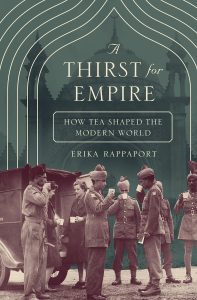 This is a heavy book that I have had my eye on for a while. Most new books I’ll wait for in the library, depending on the price. This one was constantly on hold before the quarantine, and finally cleared up when I went to return the Stonewares of Yixing.
This is a heavy book that I have had my eye on for a while. Most new books I’ll wait for in the library, depending on the price. This one was constantly on hold before the quarantine, and finally cleared up when I went to return the Stonewares of Yixing.
A Thirst for Empire reads a bit dry, and unfortunately even with ample time in quarantine (well, maybe not that much–I’m still working), I couldn’t finish it before my library “renews” ran out. It’s a bit of a slog, not really intending to weave an entertaining narrative. It’s an essay foremost and that works a bit to it’s detriment as it opens with the classic Objectives of “in this work I will prove…” Which isn’t a knock on the work, just what kind of book it is.
That said, if you have the drive and attention, this book does have a lot to offer. It focuses on the history that evolved around the economy. What influenced how tea sold in the west–to it’s history as an “oriental medicine”, to being picked up by the Temperance movement, to the taxing in the West that ultimately saw tea unpatriotized in the USA. How the rise of tea in India reshaped how China tea was seen, and how prepackaging effected grocers’ living as Skilled Tea Blenders.
I think the most interesting part I took away from this book were Rappaport’s description of that last point; how tea blending evolved. I got to see the history of how my current career track got to where it is today. And because my company is so old, see evidence of that change.
Tea blending, she explains, was originally a show of the grocer’s skill. People made a living on their reputation for blending imported teas, on the spot, into house-blends, and for specific customers. Something I see today in the old blend book we keep at work. Prepackaging did away with that–tea was pre-blended and pre-packaged, so you didn’t get a choice in your cuppa. Sold on the reputation that this was ‘cleaner’. Teas started selling on brand recognition instead, and this allowed for more reach, a benefit for big importers, but at the expense of the grocer’s trade.
A lot of tea companies changed with the times, moved away from blending and towards packaging (it first came about in the 1870s, but took several more decades to catch on). it’s only been the past few decades that there’s been a resurgence of hand-weighed tea, in the form of specialty shops. At least around here.
And it’s an odd contrast to the two types of tea sellers of yore: 1) grocery shops that also happened to weigh and sell blended tea (the closest we’ve got these days is… I don’t know, Bulk Barn? In the 90s to early 2000s, some grocers still had coffee beans and teas in bulk dispensers, but not these days. And certainly not during COVID), and 2) specialty tea shops, which were female-driven social spaces, probably a little off from the weigh-and-go/tea-and-go specialty shops of today.
My company had a very vintage setup until about 2007 when it was restructured to align more with the then-ongoing boom of modern tea shops, and in general the everyday coffee shop. But we’ve still got our old blending books (several editions, from typewriter to hand-written, to modern ongoing), and we still do house blends for customers. It’s our own secret menu, if you know about the book, and happen to have a family name noted in it. I’m definitely committed to preserving that and the company’s general history. A push towards an atmosphere that’s a little slower, more in the spirit of tea.
I could spend a lot of time going over the interesting facts in this book, but that would make this summary pretty long. It’s definitely a book I plan to buy if I find it for a good price, and stickynote the heck out of the pages.
- On Amazon, the digital edition is about $25, while the physical runs $35-55.
- Abebooks, you can score it for $10 if you happen to get lucky with shipping.




11/01/2021 at 1:37 PM
This one was already on my to buy list. Now I really have to buy and read it.